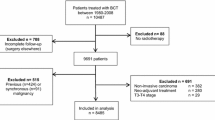Abstract
From August 1971 to August 1974, almost 1700 patients with clinically curable breast cancer in 34 institutions in the United States and Canada were entered into the National Surgical Adjuvant Breast Project (NSABP) trial comparing the results of total (simple) mastectomy with those of radical mastectomy. Patients with clinically negative axillary nodes in the total mastectomy group were further randomized to receive postoperative regional radiotherapy or no radiotherapy, but the latter patients underwent an axillary dissection if clinically positive axillary nodes developed after operation. Patients with clinically positive axillary nodes in the total mastectomy group automatically received postoperative regional radiotherapy. After a follow-up period of 2 to 5 years, there are no significant differences in the results of the various types of treatment in either the groups of patients with clinically negative axillary nodes or those with clinically positive axillary nodes.
In June 1976 the NSABP initiated a new study comparing total mastectomy plus axillary dissection, segmental mastectomy plus axillary dissection, and segmental mastectomy plus axillary dissection plus postoperative radiation of the involved breast. All patients with histologically positive axillary nodes receive adjuvant chemotherapy. In the two segmental mastectomy groups, subsequent appearance of cancer in the involved breast is treated by total mastectomy.
Résumé
D'août 1971 à août 1974, environ 1700 patientes traitées dans 34 institutions des Etats-Unis et du Canada pour cancer du sein cliniquement curable furent soumises à l'essai du National Surgical Adjuvant Breast Program (NSABP) comparant les résultats de la mastectomie simple à ceux de la mastectomie radicale. Les patientes du premier groupe, sans ganglions axillaires cliniquement perceptibles, furent réparties au hasard en deux sous-groupes, l'un recevant une radiothérapie postopératoire régionale, l'autre sans radiothérapie complémentaire. Parmi les malades du deuxième sous-groupe, celles qui ont présenté en postopératoire des signes d'envahissement ganglionnaire axillaire ont été soumises à un évidement du creux axillaire. Toutes les malades subissant une mastectomie simple, mais dont les ganglions axillaires étaient cliniquement envahis, ont reÇu une radiothérapie postopératoire régionale. Après une période d'observation allant de 2 à 5 ans, on ne constate pas de différence entre les résultats des divers traitements dans les deux groupes à ganglions axillaires envahis ou intacts.
En juin 1976, le NSABP a entrepris une nouvelle étude comparant la mastectomie totale avec dissection axillaire, la mastectomie segmentaire avec dissection axillaire et irradiation postopératoire du sein atteint. Toutes les malades ayant à l'examen histologique un envahissement des ganglions axillaires reÇoivent une chimiothérapie adjuvante. Dans les deux groupes traités par mastectomie segmentaire, la récidive locale est traitée par mastectomie totale.
Similar content being viewed by others
Author information
Authors and Affiliations
Rights and permissions
About this article
Cite this article
Fisher, B. United States trials of conservative surgery. World J. Surg. 1, 327–330 (1977). https://doi.org/10.1007/BF01556850
Issue Date:
DOI: https://doi.org/10.1007/BF01556850



